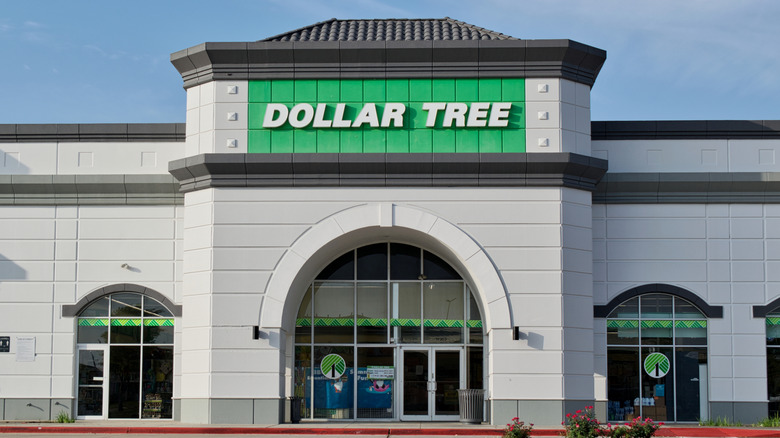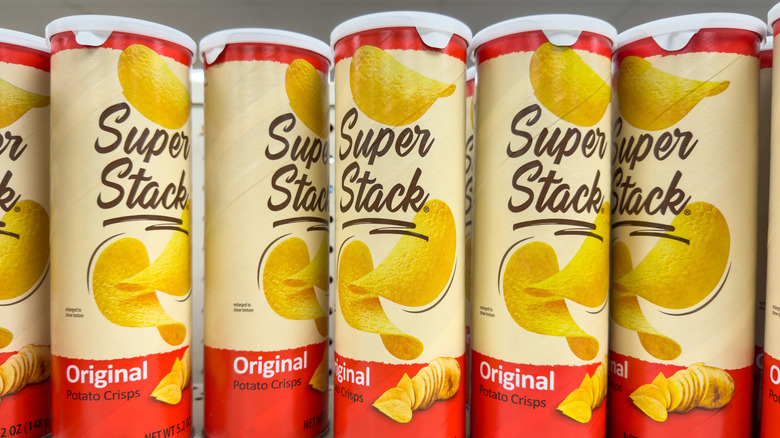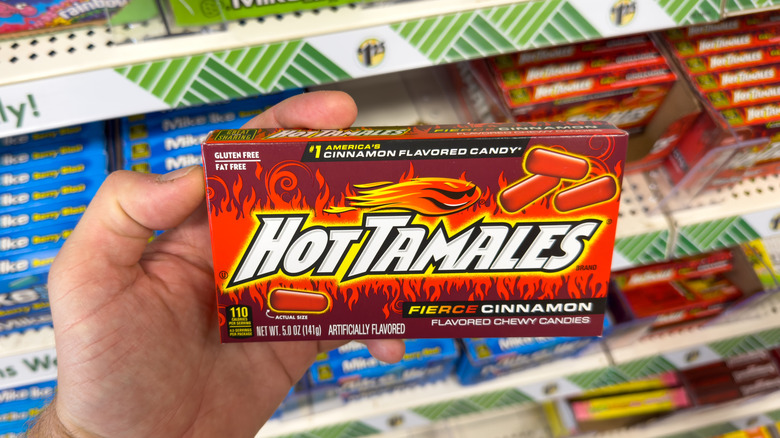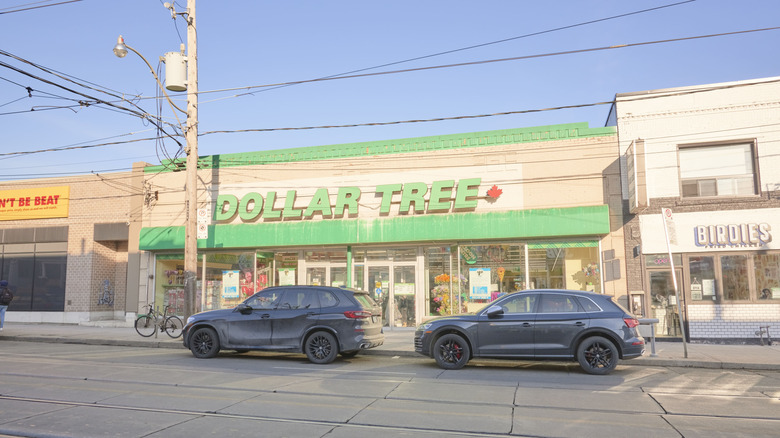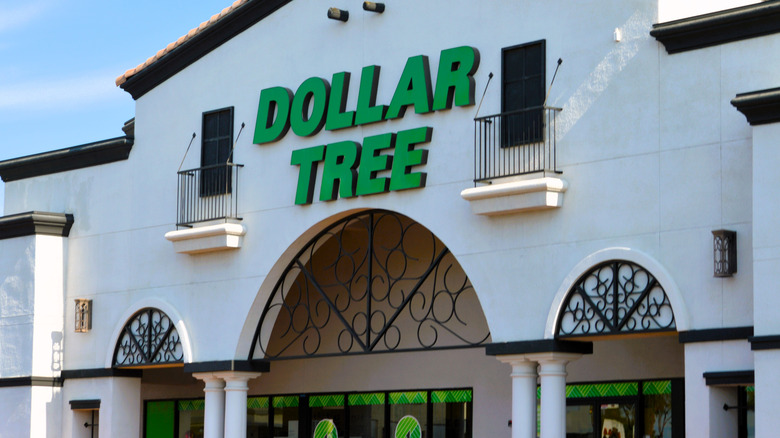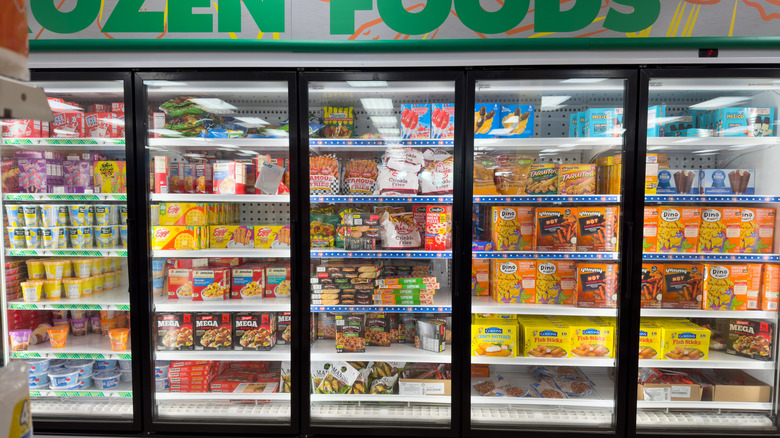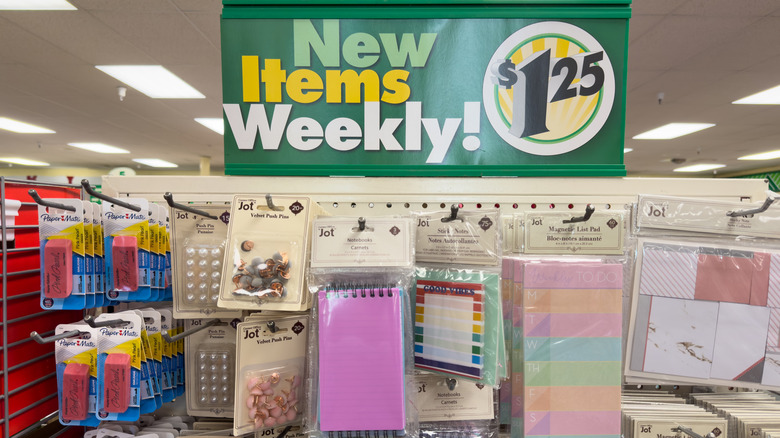What Really Makes Dollar Tree Food So Cheap?
Though Dollar Tree famously raised prices above $1 in 2023, it still easily beats out big box stores and other grocery competitors when it comes to affordability. From food, holiday decor, and appliances, Dollar Tree sells a large collection of items that appeal to a huge swath of consumers. And with many food goods costing little more than $1, buying a semi-full meal at Dollar Tree is even more affordable than buying a Chicken Big Mac from McDonalds.
Of course you won't find as large of a food selection as you will in your average grocer, but Dollar Tree supplies a variety of staples and tasty snacks. Items like canned goods, drinks, and chips are great buys at Dollar Tree, as they're often priced lower than you will find elsewhere. Let's face it: Nearly every shopper is concerned about the price of what they're buying, which makes Dollar Tree an appealing choice over grocers with higher prices such as Whole Foods or Trader Joe's, despite lacking selection.
And even with inflation, Dollar Tree continues to sell products for a fraction of the price elsewhere — particularly their food. Here is how they do it.
Using private label products
While they might not be as well known as Costco's Kirkland brand, Dollar Tree manufactures food, clothes, and even electronics under private labels in order to reduce costs for both the business and consumers. Cutting out the middle-man supplier allows Dollar Tree to cut spending costs. Instead of purchasing goods from a third-party vendor, manufacturers create a similar product for cents on the dollar. Some of Dollar Tree's private label brands include Nature's House, Home Style Select, and Klar and Danver, each of which specialize in a different department.
The Dollar Tree does carry name brand products owned by other large manufacturers, but keeps a hefty inventory of their own supply throughout the year. It may be hard to pinpoint these in the store, as nothing on the packaging suggests that they are owned and made by Dollar Tree itself. Additionally, just because it is a store-brand product does not mean it will be worse quality than some of the more well-known brands. Using private labels is a common practice among many large grocery chains, such as Kroger, Target, and Whole Foods.
Selling smaller sizes
One of the most obvious differences in the prepared foods that you'll find at Dollar Tree are that many of their snacks are packaged in smaller sizes than you'd find at a regular grocery store. An example of this is the Tyson Frozen Grilled & Ready Chicken Breast Strips — a simple frozen food item from a popular American brand. You'll find an 11.4 ounce bag at the Dollar Tree for $5, which sounds like a steal for real white-meat chicken breast. At Target, though, you can find a 22 ounce bag of the same chicken for $8.79.
While the prices are usually comparable, Dollar Tree will typically carry smaller portions when it comes to frozen foods, pre-packaged snacks, or candy. Of course, you can still find many standard-sized items like their selection of frozen pizzas. Smaller sizes are especially convenient for baking and cooking needs where you may only want a small amount of a specific ingredient, whereas you may want to skip the Dollar Tree and go to a larger grocery store if you're cooking a larger meal. The real professionals know that Dollar Tree, though, is unmatched when it comes to movie-theater style candy. Those small boxes are seldom more than $1.25 and are a perfect on-the-go sugary snack.
Partnering with bigger brands
You may have noticed on a recent shopping trip that Dollar Tree is selling a lot more name brand products than it used to. The discount store is selling more name brand products than ever before. Dollar stores like Dollar Tree are the fastest growing category of brick-and-mortar grocery stores over the past few years, and are using their newfound buying power to play in the big leagues.
Dollar Tree cuts deals with large manufacturers like Kraft and Hersheys to buy in bulk for an affordable price — so items like French's mustard, Kraft salad dressing, Kraft Mac & Cheese, Lay's Stax chips, Knorr rice and pasta, Betty Crocker Skillet potatoes, and so much more are brought to you at very low prices. "Merchandise Vendors" source and select products that fit Dollar Tree's criteria. This means searching for discounted, out of season, and, yes, smaller products to stock the shelves of their many stores.
Dollar Tree's ability to partner with large vendors left them in a league of their own, with competitors unable to keep up. In 2015, Dollar Tree acquired their competitor Family Dollar. Together, they had a fleet of 15,000 stores. Ten years later, that number has grown to above 16,000.
Operating in low rent areas
Though Dollar Tree operates all over the United States, they're selective about their real estate. With around 15,000 stores across North America, Dollar Tree typically opens shop in areas with below average rent costs. This saves them money in monthly expenses, but leads to a disproportionate number of stores in lower income areas. Many of Dollar Tree's target market areas – both rural and urban – can be considered "food deserts" where access to fresh food may already be scarce. While dollar stores save neighbors a buck in the short term, they have been known to do more harm than good to neighborhoods.
Low rent costs allow Dollar Tree to sell cheaper food, but they do not sell many healthy items like fresh produce. This is fine if there are alternative places for people to do proper grocery shopping, but Dollar Trees tend to avoid areas with large grocery competitors. That makes getting staples like bread, fruits, or even butter that much more difficult. Even worse: A study by the U.S. Department of Agriculture (USDA) shows that local, neighborhood grocers in rural communities can't compete against a new Dollar Tree in the area and are often forced to close. This leaves neighbors with even fewer options for fresh food than before.
Catering to a wide audience
Though many Dollar Trees are in low income areas, their customer base ranges across demographics and income levels. Outside of particularly urban or rural communities, Dollar Tree focuses on suburban, middle-income customers in large shopping plazas. These customers tend to shop for "wants" like home decorations or craft supplies over "needs" such as food. In turn, larger stores set in suburban areas tend to cater to their customers with more crafts and decorations.
The wide customer base across ages, demographics, and income levels makes the Dollar Tree a household name in nearly every home in America — and because of this, the company doesn't have to spend big bucks on advertising, which, in turn, results in cheaper items, including food. You'll see plenty of ads on TV for stores like Walmart, Target, or Whole Foods, but you most likely haven't seen a Dollar Tree commercial in recent memory. Social media also gives a lot of free advertising to Dollar Tree. TikTokers often share their new finds, giving free promotion to any number of large retailers. And so, a huge customer base with a very low marketing budget saves Dollar Tree tons of money annually.
The company pays low wages
Dollar Tree stores tend to be understaffed on purpose. Besides one or two cashiers and possibly a person stocking shelves, you won't typically find a store bustling with employees, regardless of how large it is. That's one of their more subtle cost-cutting measures, beyond paying low wages to the employees that do roam the store.
According to Indeed, the national average salary of a stocking associate at Dollar Tree is $10.18 per hour. A notice sent to the United States Securities and Exchange Commission states that "Dollar Tree reports that its CEO earned $13,975,672 in 2022 and that its median employee earned $14,702." While most Dollar Tree employees work part time, $14,702 is not a living wage in any state. That same year, in 2022, employees of Dollar Tree along with fair wage activists called for higher wages and more available working hours. And so, it's no surprise that paying staff low wages likely helps lower the cost of Dollar Tree's food items.
Making strategic purchase plans
Like many big box stores, Dollar Tree purchases items in bulk at a reduced cost. That means many of the food items the stores carry (think: frozen or processed foods) need to have a long shelf life. For food that does expire, Dollar Tree tends to purchase items that are close to their expiration dates that may be undesirable to other markets. This, along with purchasing foods with damaged boxes, helps reduce waste and allows dollar stores to sell food for cheaper than you would find elsewhere.
If your favorite snack at the grocery store suddenly disappeared, you may find it at Dollar Tree. These discount stores also commonly purchase liquidated or discontinued items that other stores will no longer carry. Once they're gone, though, that may be it forever. And overstock and surplus goods from other stores are a common find at Dollar Tree.
These buying habits work through a process of trial and error. Dollar Tree tries to spend money only on items that it knows can make a profit. Items — food or otherwise — that are deemed too expensive or unpopular will be discontinued from their stores. Focusing on items that they know will most likely be sold helps reduce their costs and allows for lower prices across the board.
Cheap manufacturing of non-food goods
Quality is not always the name of the game at Dollar Tree. Cheap products like batteries and office supplies can often subsidize the low cost of many of the food items that Dollar Tree sells, such as eggs or frozen vegetables. While quality might not always matter at Dollar Tree, quantity does.
Holidays and special events like Halloween or graduation generate a lot of income for Dollar Tree, which caters to these momentous occasions with affordable party supplies and essentials. These items come in and out the door rapidly, and support the rest of the stores' operations. Some of the cheap holiday home decor usually won't last past the season, and will need to be discarded and repurchased the following year. Other home essentials like brooms or spatulas are made with cheap, often unsafe materials. For the average consumer, these products are still convenient to purchase regardless of the quality. This leads to impulsive purchases and higher revenue for Dollar Tree — which, again, helps to lower the cost of foods you can buy there.
